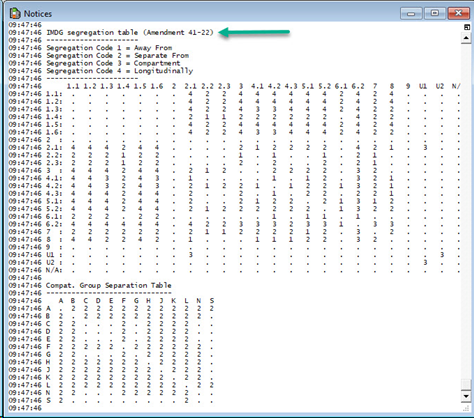 Diagnostics
Diagnostics  IMDG Segregation Matrix. You may have to scroll the window and resize it to view the entire segregation matrix.
IMDG Segregation Matrix. You may have to scroll the window and resize it to view the entire segregation matrix.The IMDG Segregation Matrix command displays hazardous vessel cargo segregation requirements based on the Segregation Table 7.2.4 of the latest IMDG Code 41-22. The following information is displayed in the Notices window:
IMDG Amendment number
IMDG segregation for all hazardous materials.
Group compatibility for Class 1 goods.
To run the IMDG Segregation Matrix command in XPS:
Select File  Diagnostics
Diagnostics  IMDG Segregation Matrix. You may have to scroll the window and resize it to view the entire segregation matrix.
IMDG Segregation Matrix. You may have to scroll the window and resize it to view the entire segregation matrix.

The segregation matrix displays IMDG D&H codes along the vertical and horizontal axes. To use the matrix to determine how to segregate two types of hazardous cargo, locate an IMDG code on one axis, then locate the other code on the other axis. Find the segregation number that appears at the intersection of the two D&H codes. This number indicates the segregation requirements for those two types of D&H cargo.
The group compatibility matrix functions exactly the same for Class 1 compatibility groups. Class 1 is comprised of explosive substances and articles, necessitating an additional level of segregation.
The segregation numbers for both matrices are defined in this table:
|
Segregation Number |
Requirement |
Segregation for Vessel |
Segregation for Yard |
|---|---|---|---|
|
1 |
Away from (when one or both containers are open) |
Open vs. Closed containers: Not in the same vertical line unless segregated by a deck Open vs. Open Containers:
|
Not checked. Yard planning should plan open hazardous containers to a special area.
|
|
2 |
Separated from |
|
|
|
3 |
Separated by a complete compartment from |
|
|
|
4 |
Separated longitudinally by a complete compartment or hold from |
Closed vs. Closed containers:
Open vs. Closed containers: above deck fore and aft: must have a minimum horizontal distance of 24 meters (78 ft) below deck fore and aft: two bulkheads not allowed in the same stack Open vs. Open Containers
|
|
|
• |
No general segregation requirements exist for these D&H containers |
|
|
Notes
Yard IMO segregation in XPS does not follow any uniform rules because requirements may vary between sites and may also depend on the local fire marshal and other regulatory bodies.
For more detailed information about segregation rules, see the International Maritime Organization Dangerous Goods Code reference books.
XPS uses the IMDG segregation table to perform dangerous and hazardous checking (if licensed at your site).